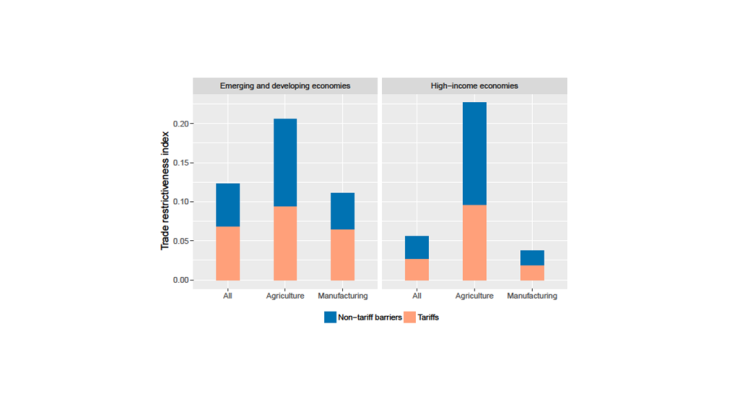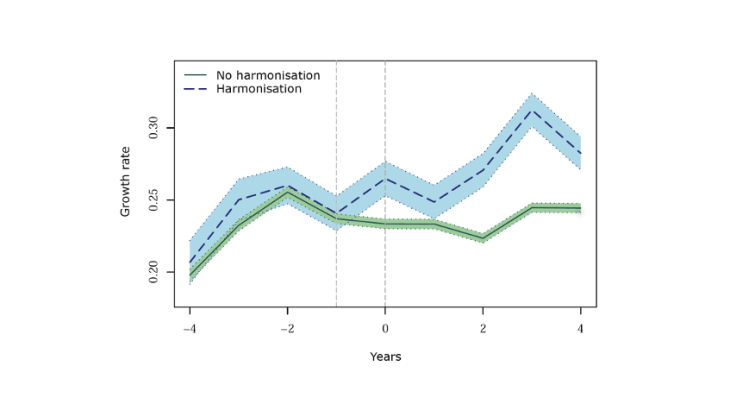- Home
- Publications et statistiques
- Publications
- Obstacles to trade: tariffs are not ever...
Post n°76. Current trade disputes focus on import tariffs. However non-tariff barriers still constitute a large share of barriers to trade. Cross-country harmonisation of product standards reduces these barriers. The trade-enhancing effects of such harmonisation efforts are equivalent to a reduction in import tariffs of 1.8 percentage points, compared to an average applied tariff rate of 2.0% for the European Union.

Source: Overall Trade Restrictiveness Index by Kee et al. (2009).
The data used were computed for the year 2009.
Trade integration is associated with a variety of benefits, both for consumers and firms. Whereas households can access a wider variety of products, firms can source inputs abroad more cheaply, benefit from technology transfer or scale economies. It is thus not surprising that the reduction of trade barriers generally constitutes an important goal of economic policies.
While the focus of trade disputes is recently centred on import tariffs, a large share of obstacles to trade is taking the form of so-called non-tariff barriers, i.e. any type of regulation that affects market access for foreign products, except import tariffs. Chart 1 shows that non-tariff barriers make up an important fraction of overall barriers to trade in both industrialised and non-industrialised economies alike. Already in 1970, when the GATT (General Agreement on Tariffs and Trade, which preceded the World Trade Organization – WTO) led to major advances in tariff reductions, Robert Baldwin wrote that "[t]he lowering of tariffs has, in effect, been like draining a swamp. The lower water level has revealed all the snags and stumps of non-tariff barriers that still have to be cleared away."
Twenty-first century trade policy: standard harmonisation
One way to get rid of the snags and stumps is to harmonise product standards. Product standards are a defining feature of industrial processes and citizens' everyday life. From environmental or safety standards to technological standards that ensure the compatibility of different devices and inputs, standardisation is widespread and affects production processes in virtually all industries (ISO, 2016). Examples of product standards include the A4 paper size, electrical plugs, safety standards for children’s toys or 4G mobile telecommunications standards.
While standards ensure a better synergy between inputs and products in a domestic context, they may constitute a barrier to trade for producers from other countries that are not subject to the same standards. However, if countries decide to harmonise their product market regulations, exporters find it easier to access foreign markets and can profit from considerable economies of scale and increasing demand for their products. For this reason, many aspects of free trade agreements that are being negotiated nowadays, such as the Comprehensive Economic and Trade Agreement (CETA), concern product market regulation and in particular standard harmonisation.
Product standards are everywhere
Trade economists often equate product standards with barriers to trade. As such, commonly used examples are health, environmental or safety standards as they can be found in the WTO’s agreements on sanitary and phytosanitary (SPS) measures or technical barriers to trade (TBT). However, one needs to keep in mind that these regulations fulfil important public policy purposes, such as environmental protection or food security.
One aspect of standardisation that is often ignored is the fact that standards apply to a large variety of products and for reasons other than health or safety aspects. Standards are widely used in technological applications to ensure the compatibility of different devices. There are positive externalities associated with this interoperability as users can profit from network effects. Standardisation can also lead to economies of scale and scope when complementary intermediate goods are used for a large variety of final products. Thus, supply chains become more detailed and complex and markets more integrated.
Chart 2 shows the distribution of harmonised standards across different standard categories. Cross-country standard harmonisation is very prevalent in materials technologies, construction and engineering. Health, safety and environmental standards actually only make up a small fraction of harmonised standards.
Standardisation is increasingly international…
Given the presumed trade-enhancing aspects of standard harmonisation, it is not surprising that a large number of product standards are increasingly set by international or supranational organisations. A large amount of this international dimension of standard harmonisation is due to the European integration process and the accompanying dominance of European standard-setting organisations. Indeed, the WTO explicitly encourages the use of international standards instead of national regulations (TBT Agreement).

Source: Schmidt and Steingress (2018).
Note: This chart displays the number of harmonised standard documents released over the 1960-2015 period.
…leading to higher trade flows among harmonising countries.
Despite the widespread idea that standard harmonisation benefits international trade, surprisingly little is known about the actual quantitative implications of such harmonisation efforts. We tackle this question by analysing the trade impact of standard harmonisation (Schmidt and Steingress, 2018).
In Chart 3, the effect of standard harmonisation is evaluated by comparing the average growth rate of trade flows before and after a harmonisation event in relation to the growth rate of trade flows of products that were never subject to standard harmonisation. A harmonisation event is defined as the release of at least one standard in the importing country which is simultaneously released in the exporting country (or has been released there in the past). One notices a significantly higher growth rate for bilateral exports after the importing country accredited a standard from an exporting country. Before the harmonisation event, there is no obvious difference in the growth rate of the two categories of products.

Source: Schmidt and Steingress (2018).
Note: This chart plots the mean growth rate before and after a harmonisation event for harmonised trade flows and non-harmonised trade flows. The point 0 denotes the timing of the event.
We also quantify the implied cost reduction of standard harmonisation by translating its effect in an equivalent change in import tariffs, i.e. we compute by how much tariffs would have to be lowered to achieve the same increase in exports as standard harmonisation (Schmidt and Steingress, 2018). The empirical estimates suggest that one harmonisation event reduces market access costs on impact by the equivalent of a tariff reduction of 1.8 percentage points.
Compared to an average applied tariff rate of 2.0% for the European Union or 1.7% for the United States (based on World Bank data for 2016), this effect appears sizable and thus supports the efforts undertaken within free-trade negotiations and international standard-setting organisations to harmonise standards.
The views expressed are those of the authors and do not necessarily reflect the position of the Bank of Canada, the Banque de France or the Eurosystem.
Updated on the 25th of July 2024